
Schinia, commonly called flower moths, is a large genus of moths belonging to the family Noctuidae. The genus has a Holarctic distribution with the vast majority of species being found in North America, many with a very restricted range and larval food plant.
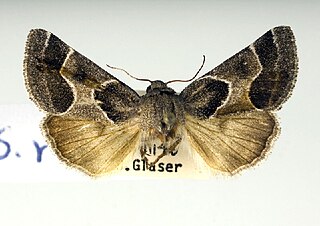
Schinia rivulosa, the ragweed flower moth, is a moth of the family Noctuidae. The species was first described by Achille Guenée in 1852. It is found in North America from Quebec to Florida, west to Arizona, north to Oregon and North Dakota. There is one generation per year.

Schinia arcigera, the arcigera flower moth, is a moth of the family Noctuidae. The species was first described by Achille Guenée in 1852. It is found in North America from Nova Scotia to Florida, west to Arizona and Idaho, north to Saskatchewan.
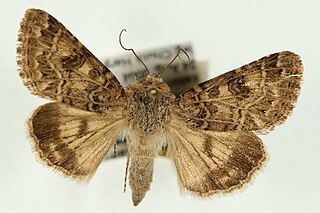
Schinia cupes is a moth of the family Noctuidae. It is found from Texas, west to New Mexico and north to Kansas and Colorado.
Schinia crotchii is a moth of the family Noctuidae. It is found from southeastern Arizona west to the Peninsular Ranges of southern California and north in south-eastern Washington and southern Idaho.

Schinia jaguarina, the jaguar flower moth, is a moth of the family Noctuidae. The species was first described by Achille Guenée in 1852. It is found on North America's Great Plains from Saskatchewan and Alberta south to Texas, eastward on coast to Florida and westward in south to Arizona. In Mexico it is found down to Mexico City.
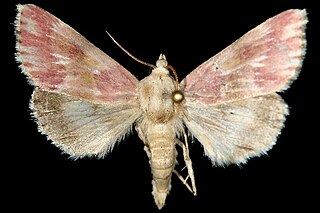
The bleeding flower moth is a moth of the family Noctuidae. It is found from North Carolina to Florida, west to Texas, north to Montana. There is also a disjunct population in Ontario.

Schinia sordida, the sordid flower moth or dingy schinia, is a moth of the family Noctuidae. The species was first described by John B. Smith in 1883. It is found in the United States from North Carolina to central Florida west to Kansas and Texas. It has also been recorded from Alabama.

Schinia aurantiaca is a moth of the family Noctuidae. It is found in North America, including California and Arizona.
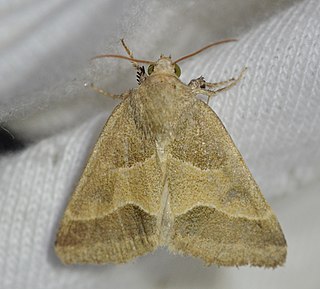
Schinia gracilenta, the slender flower moth or iva flower moth, is a moth of the family Noctuidae. The species was first described by Jacob Hübner in 1818. It is found from the US states of New York to Florida and Nebraska to Arizona. The species is listed as endangered in Connecticut.
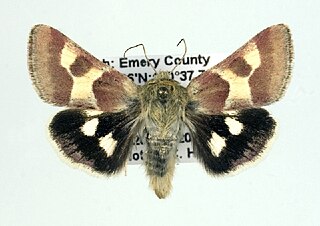
Schinia suetus is a moth of the family Noctuidae first described by Augustus Radcliffe Grote in 1873. It is widespread in the mountains of western North America, from southern Alberta west to British Columbia, south at least to Colorado and California, east to Idaho and New Mexico.
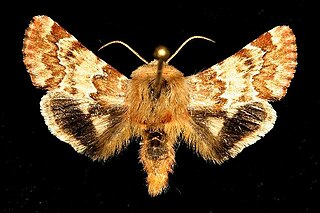
Schinia septentrionalis, the northern flower moth, is a moth of the family Noctuidae. The species was first described by Francis Walker in 1858. It is found in North America from Missouri to Quebec to South Carolina and Louisiana. Records include Colorado, Oklahoma, South Dakota and Texas. It is listed as threatened in the US state of Connecticut.

Schinia nundina, the goldenrod flower moth, is a moth of the family Noctuidae. The species was first described by Dru Drury in 1773. It is found in North America from Minnesota to southern Ontario and Nova Scotia, south to central Florida and southern Texas. Records include Arizona, Kansas, Nebraska, New York, Maryland, Oklahoma and South Carolina.
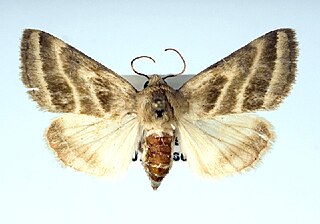
Schinia trifascia, the three-lined flower moth, is a moth of the family Noctuidae. The species was first described by Jacob Hübner in 1818. It is found in North America from Ontario and Massachusetts south to Florida and west to Arizona, Colorado and Wyoming. It has also been reported from Louisiana.

Schinia obscurata, the obscure schinia moth, is a moth of the family Noctuidae. It is found from Ontario and Quebec south into the United States, where it has been recorded from Illinois, New Jersey, South Carolina, Wisconsin, Kansas, Montana, Nebraska, North Dakota, Oklahoma and Texas.
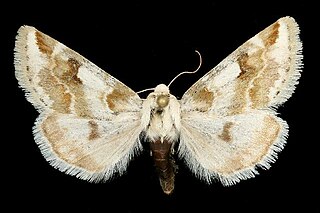
The rabbitbush flower moth is a moth of the family Noctuidae. It is found from central Arizona and New Mexico, north to Colorado, south-western Wyoming and Utah, west to Nevada and California, and north to Oregon, Idaho and Washington.

Schinia grandimedia, the Rockies boneset flower moth, is a moth of the family Noctuidae. The species was first described by David F. Hardwick in 1996. It is found in the United States from Kansas to Texas, west to Colorado and New Mexico.
Schinia aetheria is a moth of the family Noctuidae first described by William Barnes and James Halliday McDunnough in 1912. It is found in North America, including Arizona, Nevada, New Mexico and Utah.

Schinia biundulata is a moth of the family Noctuidae. It is found in western North America, including Arizona, California, Idaho, Nevada, Oregon, Texas and Utah.

Schinia psamathea is a moth of the family Noctuidae. It is known from east-central Georgia southwestward to the Panhandle of Florida, southeastern Alabama, and southwestern Mississippi. It seems to prefer sandy soils either in dune type habitats or near sandy beaches.

















